Optimum System for Diagnosing Power Quality in Electrical Microgrids
Abstract
:1. Introduction
- Prior to DiagElect, there was no electrical measurement network suitable for collecting, processing, and analyzing data for comprehensive PQ analysis in microgrids, including the detection and classification of both stationary and non-stationary PQDs.
- DiagElect is capable of accurately and instantaneously measuring voltage and current at all microgrid nodes and supports various PQ analyses, such as the identification of distortion sources.
- To the author’s knowledge, there is no electrical measurement network specifically focused on the detection of harmonic sources that is based on free software, open hardware, and uses low-cost devices.
2. Materials and Methods
2.1. Measurement Requirements
2.2. Methodology for Harmonic Flow Assessment
2.3. Experimental Setups for Evaluating DiagElect
- A grid emulator that supplies a rated phase voltage of 230 V RMS at 50 Hz.
- Four microgrid nodes representing linear, nonlinear, balanced, and unbalanced three-phase loads.
3. Developed Electrical Measurement Network
3.1. SDMD Prototype: Architecture and Characteristics
- Receiving the measurement configuration and data requests;
- Performing and temporarily saving the measurements;
- Transmitting the voltage and current measurements for further processing.
3.2. Description of the Developed Communication Network
4. Results
4.1. Performance of the SDMD
4.2. Performance of DiagElect
5. Discussion
5.1. Performance of the SDMD
5.2. Performance of DiagElect
6. Conclusions
Author Contributions
Funding
Institutional Review Board Statement
Informed Consent Statement
Data Availability Statement
Conflicts of Interest
References
- Hakimi, S.M.; Hasankhani, A.; Shafie-khah, M.; Catalão, J.P.S. Demand Response Method for Smart Microgrids Considering High Renewable Energies Penetration. Sustain. Energy Grids Netw. 2020, 21, 100325. [Google Scholar] [CrossRef]
- Tang, J.; Ni, H.; Peng, R.-L.; Wang, N.; Zuo, L. A Review on Energy Conversion Using Hybrid Photovoltaic and Thermoelectric Systems. J. Power Sources 2023, 562, 232785. [Google Scholar] [CrossRef]
- Eltigani, D.; Masri, S. Challenges of Integrating Renewable Energy Sources to Smart Grids: A Review. Renew. Sustain. Energy Rev. 2015, 52, 770–780. [Google Scholar] [CrossRef]
- Zhang, Q.; Dehghanpour, K.; Wang, Z. Distributed CVR in Unbalanced Distribution Systems with PV Penetration. IEEE Trans. Smart Grid 2019, 10, 5308–5319. [Google Scholar] [CrossRef]
- Kabalci, Y. A Survey on Smart Metering and Smart Grid Communication. Renew. Sustain. Energy Rev. 2016, 57, 302–318. [Google Scholar] [CrossRef]
- Bhattacharyya, S.; Cobben, S.; Bhattacharyya, S.; Cobben, S. Consequences of Poor Power Quality—An Overview; IntechOpen: London, UK, 2011; ISBN 978-953-307-180-0. [Google Scholar]
- Igual, R.; Medrano, C. Research Challenges in Real-Time Classification of Power Quality Disturbances Applicable to Microgrids: A Systematic Review. Renew. Sustain. Energy Rev. 2020, 132, 110050. [Google Scholar] [CrossRef]
- Garcia, C.I.; Grasso, F.; Luchetta, A.; Piccirilli, M.C.; Paolucci, L.; Talluri, G. A Comparison of Power Quality Disturbance Detection and Classification Methods Using CNN, LSTM and CNN-LSTM. Appl. Sci. 2020, 10, 6755. [Google Scholar] [CrossRef]
- Grasso, F.; Paolucci, L.; Bacci, T.; Talluri, G.; Cenghialta, F.; D’Antuono, E.; de Giorgis, S. Simulation Model and Experimental Setup for Power Quality Disturbances Methodologies Testing and Validation. In Proceedings of the 2019 IEEE 5th International forum on Research and Technology for Society and Industry (RTSI), Florence, Italy, 9–12 September 2019; pp. 359–363. [Google Scholar]
- EN 50160:2022; Voltage Characteristics of Electricity Supplied by Public Distribution Network. BSI Standard Publication: London, UK, 2022.
- Herrera, R.S.; Salmerón, P. Harmonic Disturbance Identification in Electrical Systems with Capacitor Banks. Electr. Power Syst. Res. 2012, 82, 18–26. [Google Scholar] [CrossRef]
- IEC 61000-2-2:2002; Compatibility Levels for Low-Frequency Conducted Disturbances and Signalling in Public Low-Voltage Power Supply Systems. International Electrotechnical Commision: London, UK, 2022.
- Sinvula, R.; Abo-Al-Ez, K.M.; Kahn, M.T. Harmonic Source Detection Methods: A Systematic Literature Review. IEEE Access 2019, 7, 74283–74299. [Google Scholar] [CrossRef]
- Fernandes, R.A.S.; Oleskovicz, M.; Da Silva, I.N. Harmonic Source Location and Identification in Radial Distribution Feeders: An Approach Based on Particle Swarm Optimization Algorithm. IEEE Trans. Ind. Inform. 2022, 18, 3171–3179. [Google Scholar] [CrossRef]
- Herrera, R.S.; Vázquez, J.R. Identification of Unbalanced Loads in Electric Power Systems. Int. Trans. Electr. Energy Syst. 2014, 24, 1232–1243. [Google Scholar] [CrossRef]
- Martin, A.D.; Herrera, R.S.; Vazquez, J.R.; Crolla, P.; Burt, G.M. Unbalance and Harmonic Distortion Assessment in an Experimental Distribution Network. Electr. Power Syst. Res. 2015, 127, 271–279. [Google Scholar] [CrossRef]
- Sánchez-Herrera, R.; Clavijo-Camacho, J.; Gómez-Ruiz, G.; Vázquez, J.R. Identification of Both Distortion and Imbalance Sources in Electrical Installations: A Comparative Assessment. Energies 2024, 17, 2536. [Google Scholar] [CrossRef]
- Fluke Corporation. Fluke Electronics, Calibration and Networks. Available online: https://www.fluke.com/ (accessed on 21 June 2023).
- Comprehensive Products and Solutions for Electrical Energy Efficiency. Available online: https://circutor.com/ (accessed on 21 June 2023).
- Powerside. PQube® 3 Power Analyzers. Available online: https://powerside.com/products/power-quality-measurement-solutions/pqube-3-power-analyzers/ (accessed on 26 October 2023).
- Cristaldi, L.; Ferrero, A.; Salicone, S. A Distributed System for Electric Power Quality Measurement. IEEE Trans. Instrum. Meas. 2002, 51, 776–781. [Google Scholar] [CrossRef]
- Bucci, G.; Fiorucci, E.; Landi, C. Digital Measurement Station for Power Quality Analysis in Distributed Environments. IEEE Trans. Instrum. Meas. 2003, 52, 75–84. [Google Scholar] [CrossRef]
- Babaev, S.; Singh, R.S.; Cobben, S.; Ćuk, V.; Downie, A. Multi-Point Time-Synchronized Waveform Recording for the Analysis of Wide-Area Harmonic Propagation. Appl. Sci. 2020, 10, 3869. [Google Scholar] [CrossRef]
- Roy, S.; Bedanta, B.; Dawnee, S. Advanced Metering Infrastructure for Real Time Load Management in a Smart Grid. In Proceedings of the 2015 International Conference on Power and Advanced Control Engineering (ICPACE), Bengaluru, India, 12–14 August 2015; pp. 104–108. [Google Scholar]
- Laverty, D.M.; Best, R.J.; Brogan, P.; Al Khatib, I.; Vanfretti, L.; Morrow, D.J. The OpenPMU Platform for Open-Source Phasor Measurements. IEEE Trans. Instrum. Meas. 2013, 62, 701–709. [Google Scholar] [CrossRef]
- Shaaban, M.F.; Osman, A.H.; Aseeri, F.M. A Multi-Objective Allocation Approach for Power Quality Monitoring Devices. IEEE Access 2019, 7, 40866–40877. [Google Scholar] [CrossRef]
- Cataliotti, A.; Cosentino, V.; Di Cara, D.; Tinè, G. LV Measurement Device Placement for Load Flow Analysis in MV Smart Grids. IEEE Trans. Instrum. Meas. 2016, 65, 999–1006. [Google Scholar] [CrossRef]
- Piatek, K.; Firlit, A.; Chmielowiec, K.; Dutka, M.; Barczentewicz, S.; Hanzelka, Z. Optimal Selection of Metering Points for Power Quality Measurements in Distribution System. Energies 2021, 14, 1202. [Google Scholar] [CrossRef]
- Kabalcı, E.; Kabalcı, Y.; Siano, P. Design and Implementation of a Smart Metering Infrastructure for Low Voltage Microgrids. Int. J. Electr. Power Energy Syst. 2022, 134, 107375. [Google Scholar] [CrossRef]
- Kaur, A.P.; Singh, M. Design and Development of a Three-Phase Net Meter for V2G Enabled Charging Stations of Electric Vehicles. Sustain. Energy Grids Netw. 2022, 30, 100598. [Google Scholar] [CrossRef]
- Mudaliar, M.D.; Sivakumar, N. IoT Based Real Time Energy Monitoring System Using Raspberry Pi. Internet Things 2020, 12, 100292. [Google Scholar] [CrossRef]
- Rodrigues Junior, W.L.; Borges, F.A.S.; Veloso, A.F. da S.; Rabêlo, R. de A.L.; Rodrigues, J.J.P.C. Low Voltage Smart Meter for Monitoring of Power Quality Disturbances Applied in Smart Grid. Measurement 2019, 147, 106890. [Google Scholar] [CrossRef]
- Alonso-Rosa, M.; Gil-de-Castro, A.; Medina-Gracia, R.; Moreno-Munoz, A.; Cañete-Carmona, E. Novel Internet of Things Platform for In-Building Power Quality Submetering. Appl. Sci. 2018, 8, 1320. [Google Scholar] [CrossRef]
- Mendi, Y.M.; Akinc, H.; Başalan, İ.; Atlı, D.; Civelek, Y. Design and Implementation of Smart Meters with Hybride Communication System Architecture. In Proceedings of the 2019 IEEE PES Innovative Smart Grid Technologies Europe (ISGT-Europe), Bucharest, Romania, 29 September–2 October 2019; pp. 1–5. [Google Scholar]
- Matthee, A.; Moonen, N.; Leferink, F. Synchronous Multipoint Low-Frequency EMI Measurement and Applications. IEEE Lett. Electromagn. Compat. Pract. Appl. 2022, 4, 120–124. [Google Scholar] [CrossRef]
- Batista, Í.J.; Barreto, L.H.S.C. Wireless Web-Based Power Quality Monitoring System in a Microgrid. In Proceedings of the 2018 Simposio Brasileiro de Sistemas Eletricos (SBSE), Niteroi, Brazil, 12–16 May 2018; pp. 1–4. [Google Scholar]
- de Souza, G.P.; Boaventura, W. do C. Time-Alignment of Electrical Network Measurements through Time Series of Cycle RMS Values. Int. J. Electr. Power Energy Syst. 2023, 144, 108518. [Google Scholar] [CrossRef]
- Castello, P.; Murenu, A.; Pegoraro, P.A.; Sulis, S. Accurate Measurement System for Power Quality Monitoring in a Real Grid Context. In Proceedings of the 2020 IEEE PES Innovative Smart Grid Technologies Europe (ISGT-Europe), Delft, The Netherlands, 26–28 October 2020; pp. 1120–1125. [Google Scholar]
- IEC 62053-21:2020; Electricity Metering Equipment—Particular Requirements—Part 21: Static Meters for AC Active Energy (Classes 0, 5, 1 and 2). International Electrotechnical Commision: London, UK, 2020.
- IEC 61850-3:2013; Communication Networks and Systems for Power Utility Automation—Part 3: General Requirements. International Electrotechnical Commision: London, UK, 2013.
- Castello, P.; Muscas, C.; Pegoraro, P.A.; Sulis, S. Synchronization Solutions for Power Quality Functionalities in Low Cost Smart Meters. In Proceedings of the 2022 IEEE International Instrumentation and Measurement Technology Conference (I2MTC), Ottawa, ON, Canada, 16–19 May 2022; pp. 1–6. [Google Scholar]
- Muscas, C. Assessment of Electric Power Quality: Indices for Identifying Disturbing Loads. Eur. Trans. Electr. Power 1998, 8, 287–292. [Google Scholar] [CrossRef]
- Sahani, M.; Dash, P.K. Automatic Power Quality Events Recognition Based on Hilbert Huang Transform and Weighted Bidirectional Extreme Learning Machine. IEEE Trans. Ind. Inform. 2018, 14, 3849–3858. [Google Scholar] [CrossRef]
- IEEE Std 1159-2019; IEEE Recommended Practice for Monitoring Electric Power Quality. IEEE: Piscataway Township, NJ, USA, 2019. [CrossRef]
- Sayed, S.; Hussain, T.; Gastli, A.; Benammar, M. Design and Realization of an Open-Source and Modular Smart Meter. Energy Sci. Eng. 2019, 7, 1405–1422. [Google Scholar] [CrossRef]
- Havrlík, M.; Libra, M.; Poulek, V.; Kouřím, P. Analysis of Output Signal Distortion of Galvanic Isolation Circuits for Monitoring the Mains Voltage Waveform. Sensors 2022, 22, 7769. [Google Scholar] [CrossRef] [PubMed]
- Elvira-Ortiz, D.A.; Morinigo-Sotelo, D.; Zorita-Lamadrid, A.L.; Osornio-Rios, R.A.; Romero-Troncoso, R.d.J. Fundamental Frequency Suppression for the Detection of Broken Bar in Induction Motors at Low Slip and Frequency. Appl. Sci. 2020, 10, 4160. [Google Scholar] [CrossRef]
- Conti, G.; Jimenez, D.; del Rio, A.; Castano-Solis, S.; Serrano, J.; Fraile-Ardanuy, J. A Multi-Port Hardware Energy Meter System for Data Centers and Server Farms Monitoring. Sensors 2022, 23, 119. [Google Scholar] [CrossRef] [PubMed]
- Parimala, K.V.; Nisha, K.C.R.; Nemichandran. FPGA Based Power Quality Monitoring Using FFT Method for Single Phase Power Metering. In Proceedings of the 2016 International Conference on Emerging Technological Trends (ICETT), Kollam, India, 21–22 October 2016; pp. 1–6. [Google Scholar]
- Ribeiro, E.G.; Mendes, T.M.; Dias, G.L.; Faria, E.R.S.; Viana, F.M.; Barbosa, B.H.G.; Ferreira, D.D. Real-Time System for Automatic Detection and Classification of Single and Multiple Power Quality Disturbances. Measurement 2018, 128, 276–283. [Google Scholar] [CrossRef]
- Websockets. An Implementation of the WebSocket Protocol (RFC 6455 & 7692). Available online: https://pypi.org/project/websockets/ (accessed on 24 July 2024).
- IEC 62052-11:2003; Electricity Metering Equipment (AC)—General Requirements, Tests and Test Conditions. Part 11: Metering Equipment. International Electrotechnical Commision: London, UK, 2003.




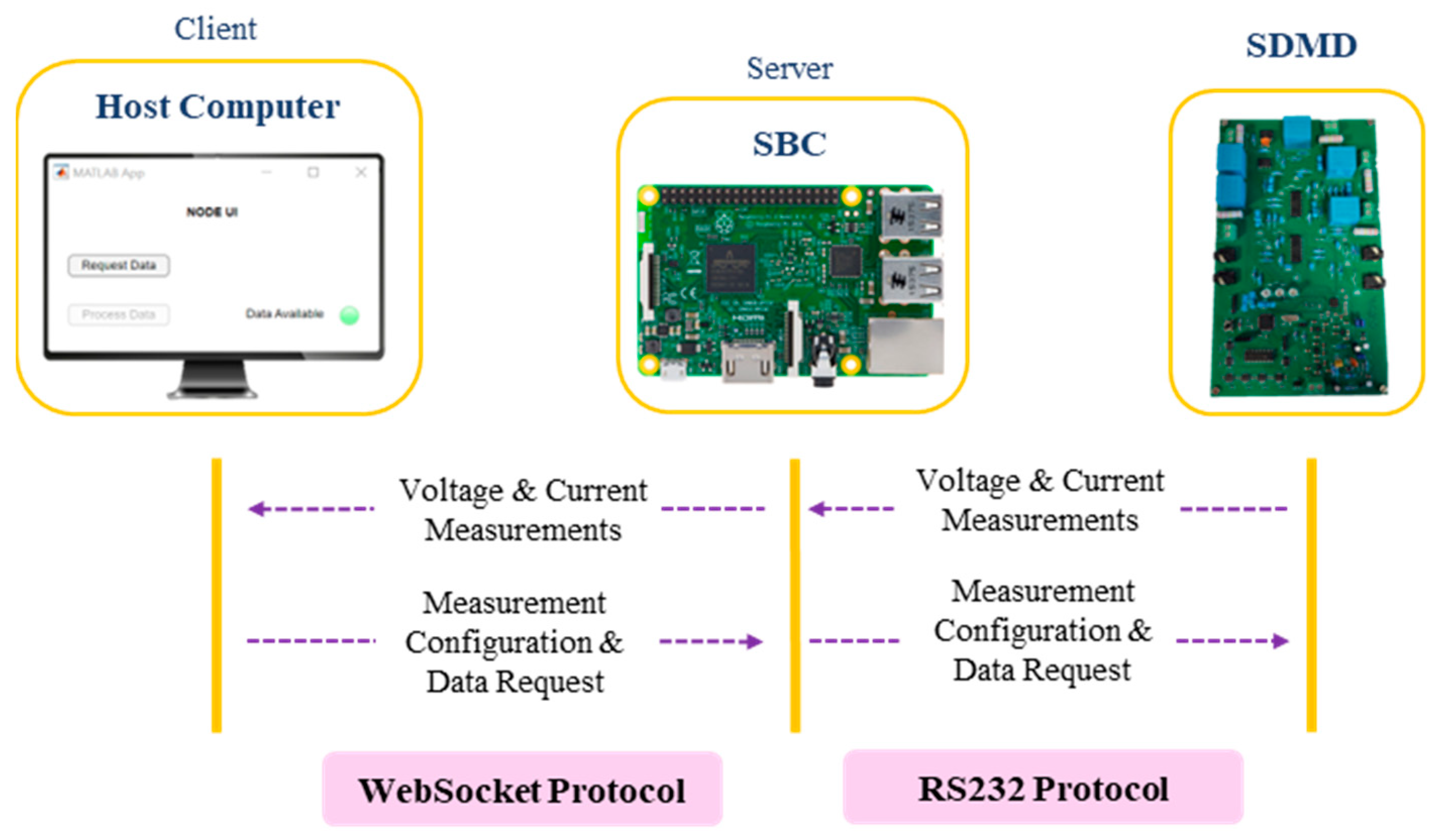
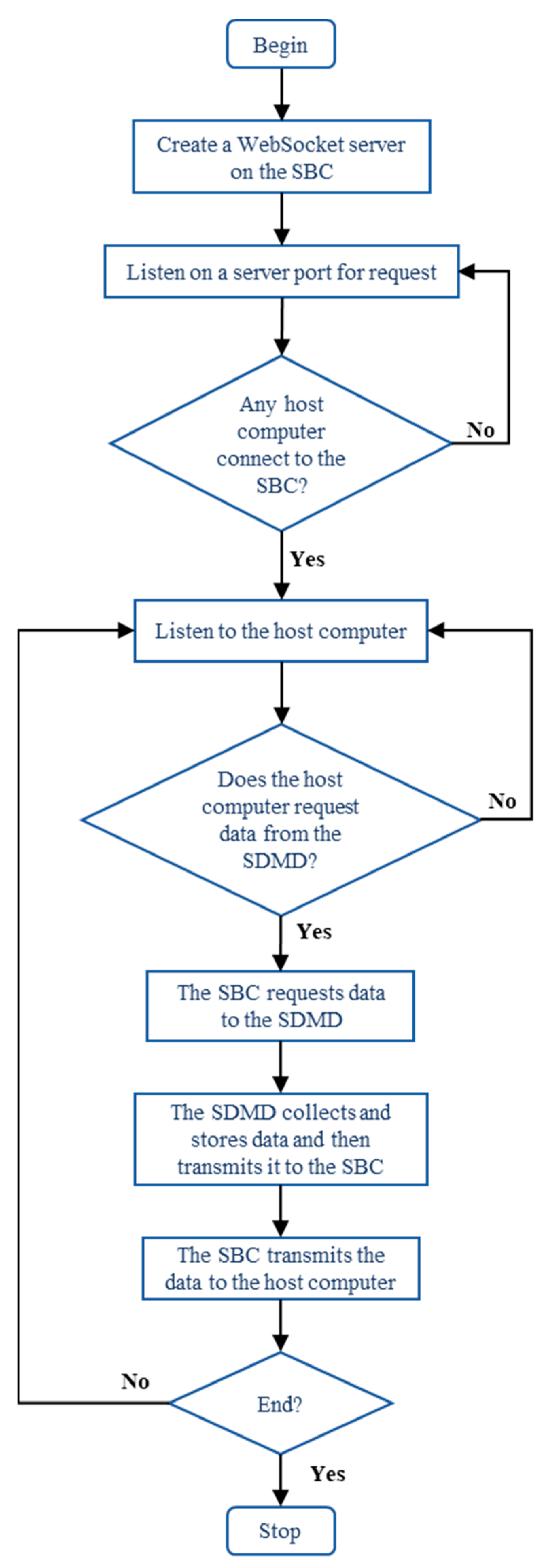
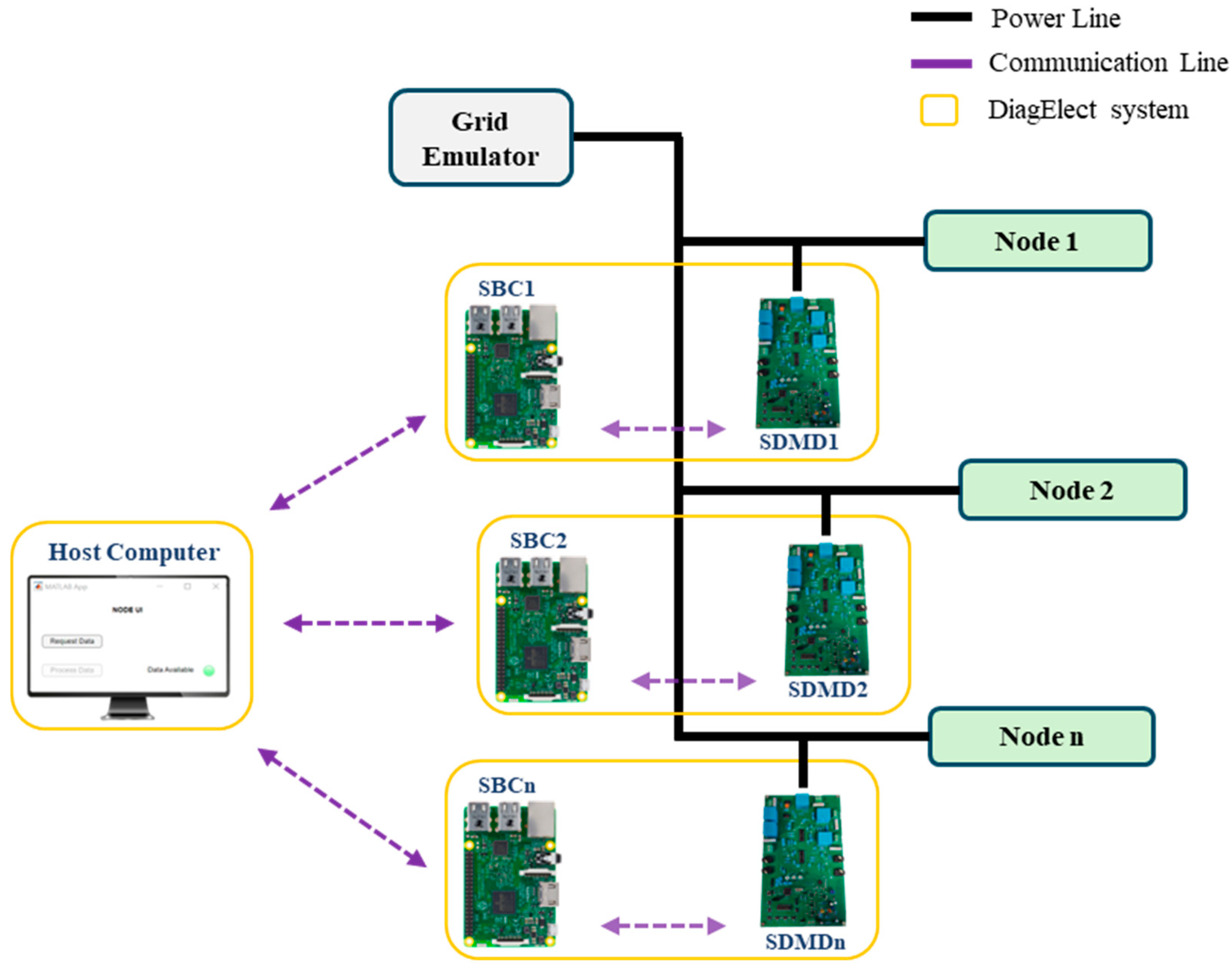

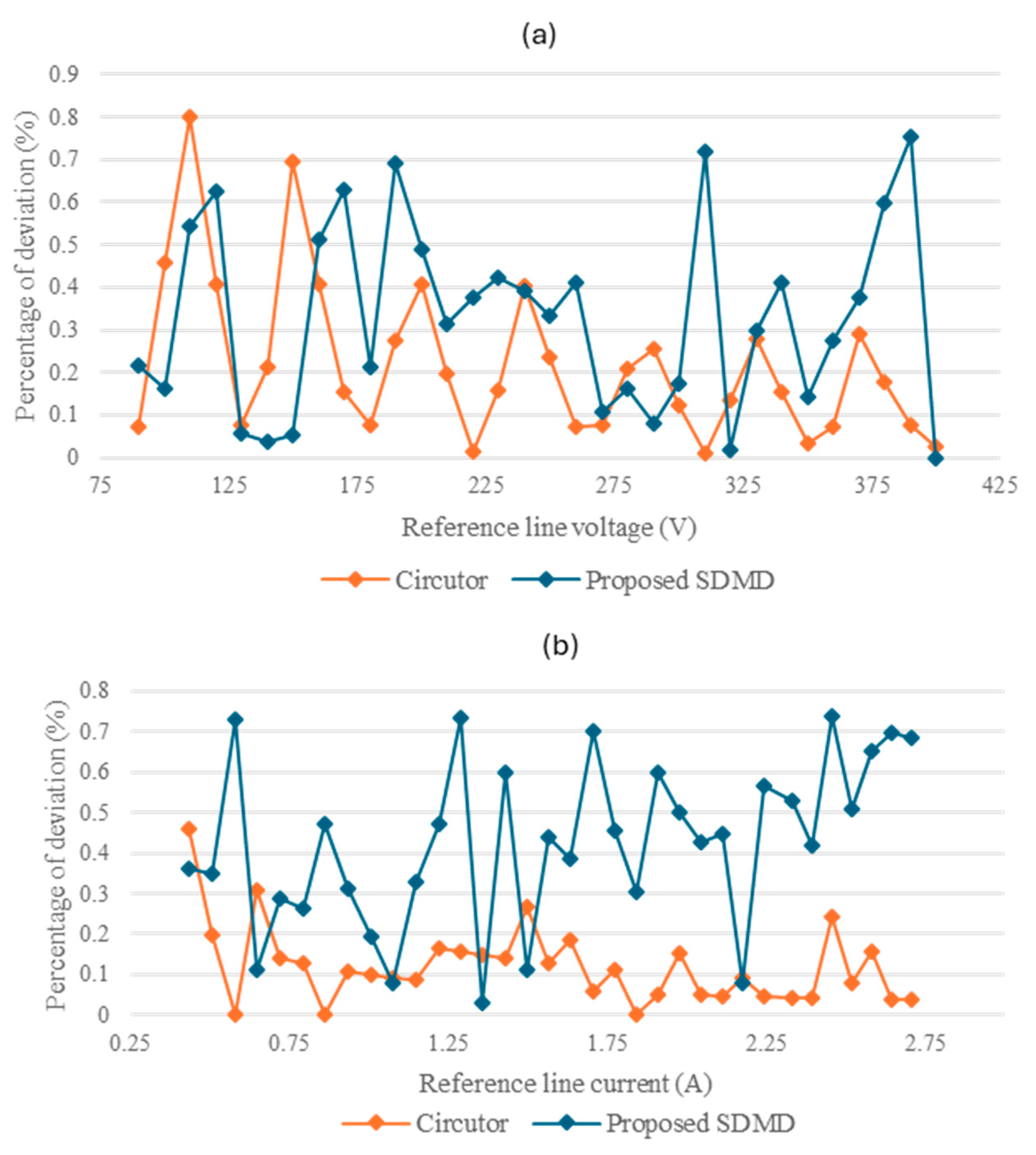


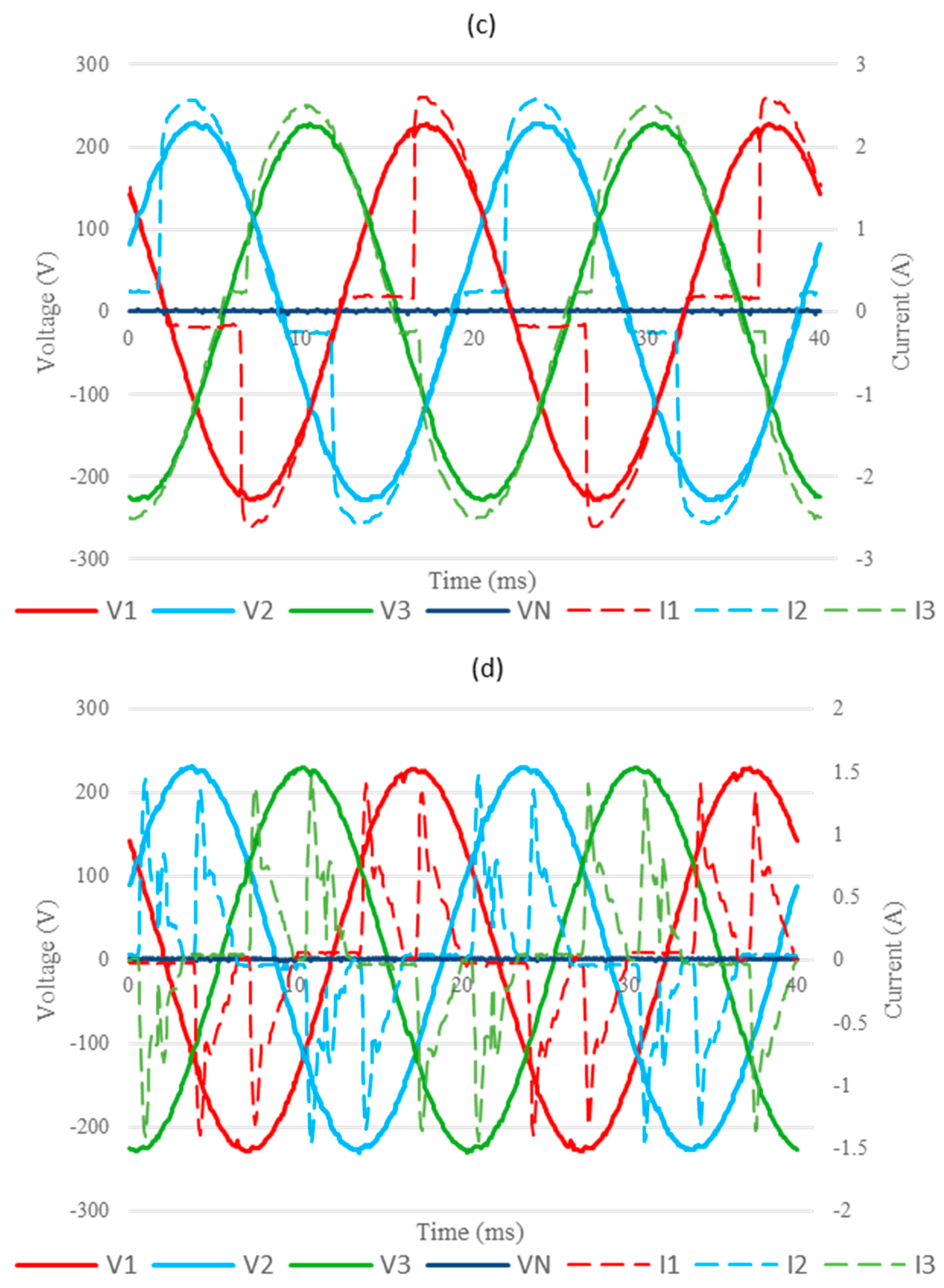
| Ref. | Detection and Classification of PQ Disturbances | Synchronous Measurements across Multiple Points | Low Cost-Devices, Open-Hardware Platforms | Scalability and Portability |
|---|---|---|---|---|
| [34] | X | |||
| [35] | X | |||
| [36] | X | X | X | |
| [37] | X | X | ||
| [38] | X | X | X | |
| DiagElect | X | X | X | X |
| Node | Load Type | Expected Distortion/Non-Distortion Source |
|---|---|---|
| Node 1 | 3-phase Unbalanced R Load | Non-distorting |
| Node 2 | 3-phase Balanced RL Load | Non-distorting |
| Node 3 | 3-phase Voltage Regulator | Distortion source |
| Node 4 | 3-phase Rectifier | Distortion source |
| Parameters | Value |
|---|---|
| Voltage range | 0–400 V |
| Current range | 0–30 A |
| Resolution | 156 µV |
| Supply voltage | 4.5–16 V |
| Communication | RS232 |
| Dimension | 199 × 116 mm2 |
| Node 1 | Node 2 | Node 3 | Node 4 | |
|---|---|---|---|---|
| (%) | 1.14 | 1.14 | 1.14 | 1.14 |
| (%) | 1.13 | 1.16 | 28.90 | 66.46 |
| (W) | 645.7 | 61.7 | 723.7 | 169.8 |
| (W) | 645.6 | 61.6 | 724.2 | 169.9 |
| (Var) | 4.62 | 232.9 | 94.0 | 48.3 |
| (Var) | 4.62 | 232.9 | 94.7 | 47.5 |
| (%) | 0.00 | 0.53 | 23.79 | 56.97 |
Disclaimer/Publisher’s Note: The statements, opinions and data contained in all publications are solely those of the individual author(s) and contributor(s) and not of MDPI and/or the editor(s). MDPI and/or the editor(s) disclaim responsibility for any injury to people or property resulting from any ideas, methods, instructions or products referred to in the content. |
© 2024 by the authors. Licensee MDPI, Basel, Switzerland. This article is an open access article distributed under the terms and conditions of the Creative Commons Attribution (CC BY) license (https://creativecommons.org/licenses/by/4.0/).
Share and Cite
Gómez-Ruiz, G.; Sánchez-Herrera, R.; Martin, A.D.; Andújar, J.M. Optimum System for Diagnosing Power Quality in Electrical Microgrids. Appl. Sci. 2024, 14, 7666. https://doi.org/10.3390/app14177666
Gómez-Ruiz G, Sánchez-Herrera R, Martin AD, Andújar JM. Optimum System for Diagnosing Power Quality in Electrical Microgrids. Applied Sciences. 2024; 14(17):7666. https://doi.org/10.3390/app14177666
Chicago/Turabian StyleGómez-Ruiz, Gabriel, Reyes Sánchez-Herrera, Aránzazu D. Martin, and José M. Andújar. 2024. "Optimum System for Diagnosing Power Quality in Electrical Microgrids" Applied Sciences 14, no. 17: 7666. https://doi.org/10.3390/app14177666






